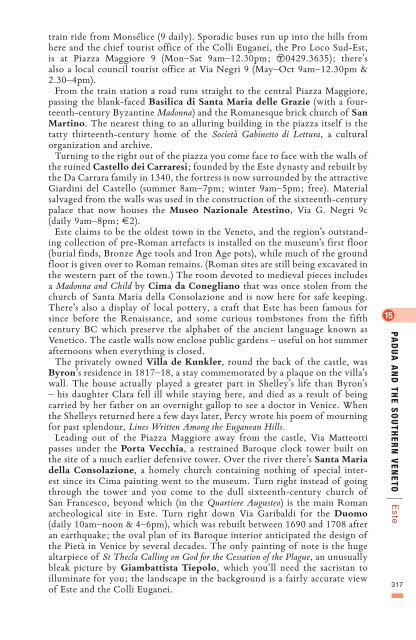You also want an ePaper? Increase the reach of your titles
YUMPU automatically turns print PDFs into web optimized ePapers that Google loves.
train ride from Monsélice (9 daily). Sporadic buses run up in<strong>to</strong> <strong>the</strong> hills from<br />
here <strong>and</strong> <strong>the</strong> chief <strong>to</strong>urist office of <strong>the</strong> Colli Euganei, <strong>the</strong> Pro Loco Sud-Est,<br />
is at Piazza Maggiore 9 (Mon–Sat 9am–12.30pm; t0429.3635); <strong>the</strong>re’s<br />
also a local council <strong>to</strong>urist office at Via Negri 9 (May–Oct 9am–12.30pm &<br />
2.30–4pm).<br />
From <strong>the</strong> train station a road runs straight <strong>to</strong> <strong>the</strong> central Piazza Maggiore,<br />
passing <strong>the</strong> blank-faced Basilica di Santa Maria delle Grazie (with a fourteenth-century<br />
Byzantine Madonna) <strong>and</strong> <strong>the</strong> Romanesque brick church of San<br />
Martino. <strong>The</strong> nearest thing <strong>to</strong> an alluring building in <strong>the</strong> piazza itself is <strong>the</strong><br />
tatty thirteenth-century home of <strong>the</strong> Società Gabinet<strong>to</strong> di Lettura, a cultural<br />
organization <strong>and</strong> archive.<br />
Turning <strong>to</strong> <strong>the</strong> right out of <strong>the</strong> piazza you come face <strong>to</strong> face with <strong>the</strong> walls of<br />
<strong>the</strong> ruined Castello dei Carraresi; founded by <strong>the</strong> Este dynasty <strong>and</strong> rebuilt by<br />
<strong>the</strong> Da Carrara family in 1340, <strong>the</strong> fortress is now surrounded by <strong>the</strong> attractive<br />
Giardini del Castello (summer 8am–7pm; winter 9am–5pm; free). Material<br />
salvaged from <strong>the</strong> walls was used in <strong>the</strong> construction of <strong>the</strong> sixteenth-century<br />
palace that now houses <strong>the</strong> Museo Nazionale Atestino, Via G. Negri 9c<br />
(daily 9am–8pm; e2).<br />
Este claims <strong>to</strong> be <strong>the</strong> oldest <strong>to</strong>wn in <strong>the</strong> Vene<strong>to</strong>, <strong>and</strong> <strong>the</strong> region’s outst<strong>and</strong>ing<br />
collection of pre-Roman artefacts is installed on <strong>the</strong> museum’s first floor<br />
(burial finds, Bronze Age <strong>to</strong>ols <strong>and</strong> Iron Age pots), while much of <strong>the</strong> ground<br />
floor is given over <strong>to</strong> Roman remains. (Roman sites are still being excavated in<br />
<strong>the</strong> western part of <strong>the</strong> <strong>to</strong>wn.) <strong>The</strong> room devoted <strong>to</strong> medieval pieces includes<br />
a Madonna <strong>and</strong> Child by Cima da Conegliano that was once s<strong>to</strong>len from <strong>the</strong><br />
church of Santa Maria della Consolazione <strong>and</strong> is now here for safe keeping.<br />
<strong>The</strong>re’s also a display of local pottery, a craft that Este has been famous for<br />
since before <strong>the</strong> Renaissance, <strong>and</strong> some curious <strong>to</strong>mbs<strong>to</strong>nes from <strong>the</strong> fifth<br />
century BC which preserve <strong>the</strong> alphabet of <strong>the</strong> ancient language known as<br />
Venetico. <strong>The</strong> castle walls now enclose public gardens – useful on hot summer<br />
afternoons when everything is closed.<br />
<strong>The</strong> privately owned Villa de Kunkler, round <strong>the</strong> back of <strong>the</strong> castle, was<br />
Byron’s residence in 1817–18, a stay commemorated by a plaque on <strong>the</strong> villa’s<br />
wall. <strong>The</strong> house actually played a greater part in Shelley’s life than Byron’s<br />
– his daughter Clara fell ill while staying here, <strong>and</strong> died as a result of being<br />
carried by her fa<strong>the</strong>r on an overnight gallop <strong>to</strong> see a doc<strong>to</strong>r in <strong>Venice</strong>. When<br />
<strong>the</strong> Shelleys returned here a few days later, Percy wrote his poem of mourning<br />
for past splendour, Lines Written Among <strong>the</strong> Euganean Hills.<br />
Leading out of <strong>the</strong> Piazza Maggiore away from <strong>the</strong> castle, Via Matteotti<br />
passes under <strong>the</strong> Porta Vecchia, a restrained Baroque clock <strong>to</strong>wer built on<br />
<strong>the</strong> site of a much earlier defensive <strong>to</strong>wer. Over <strong>the</strong> river <strong>the</strong>re’s Santa Maria<br />
della Consolazione, a homely church containing nothing of special interest<br />
since its Cima painting went <strong>to</strong> <strong>the</strong> museum. Turn right instead of going<br />
through <strong>the</strong> <strong>to</strong>wer <strong>and</strong> you come <strong>to</strong> <strong>the</strong> dull sixteenth-century church of<br />
San Francesco, beyond which (in <strong>the</strong> Quartiere Augusteo) is <strong>the</strong> main Roman<br />
archeological site in Este. Turn right down Via Garibaldi for <strong>the</strong> Duomo<br />
(daily 10am–noon & 4–6pm), which was rebuilt between 1690 <strong>and</strong> 1708 after<br />
an earthquake; <strong>the</strong> oval plan of its Baroque interior anticipated <strong>the</strong> design of<br />
<strong>the</strong> Pietà in <strong>Venice</strong> by several decades. <strong>The</strong> only painting of note is <strong>the</strong> huge<br />
altarpiece of St <strong>The</strong>cla Calling on God for <strong>the</strong> Cessation of <strong>the</strong> Plague, an unusually<br />
bleak picture by Giambattista Tiepolo, which you’ll need <strong>the</strong> sacristan <strong>to</strong><br />
illuminate for you; <strong>the</strong> l<strong>and</strong>scape in <strong>the</strong> background is a fairly accurate view<br />
of Este <strong>and</strong> <strong>the</strong> Colli Euganei.<br />
Padua <strong>and</strong> <strong>the</strong> sou<strong>the</strong>rn vene<strong>to</strong><br />
| Este<br />
317







